The Beastie Boys

Synopsis of Pop Music
"Oh yes indeed it’s fun time, fun time…”
The phrase 'all white rap group' tends to strike fear in the hearts of serious rap fans, and tough-talking boys who shout instead of sing and play nary an instrument, well they tend to raise the eyebrows of serious rock fans. So of course The Beasties were dismissed early on as just an obnoxious jerk triptych, imposters to both rap and rock. But the boys turned out to be much craftier and endearing than their critics ever dreamed…and yes, they even picked up some instruments eventually. For that early 80's post-punk, definitely-in-need-of-some-new-blood rock scene, as well as for the world of burgeoning rap, The Beastie Boys stretched the seams of the genres and are recognized now as vanguards. Shouting, cussing, and clowning vanguards—but vanguards nonetheless.
A 1981 birthday party for Adam Yauch ('MCA') was the band’s first venue—which back then was a hardcore punk outfit that included Yauch, Michael Diamond ('Mike D'), drummer Kate Schellenbach and guitarist John Berry. After the independent release of the Beasties’ Polly Wog Stew EP, Adam Horowitz ('King Ad-Rock') left the punk outfit he was playing with, The Young and the Useless, to join up. The Beasties attacked the New York club scene, raising hell at haunts like CBGB’s and Danceteria, and their hip-hop sound started to fill out.
Schellenbach and Berry left the band in ’83 (coming together later as Luscious Jackson and Thwig), and the remaining three hellions released “Cookie Puss” as a single, based on a crank phone call to Carvel Ice Cream. Their irreverence was well received, as was the single’s flip side called “Beastie Revolution”—which was used by British Airways for a commercial to the eventual tune of $40,000—dropped right into their baggy-panted laps.
Rick Rubin, a friend and NYU student at the time, scratched on turntables for the trio and eventually signed them to his newly-formed Def Jam label. Rubin then introduced manager (and his soon-to-be partner) Russell Simmons to the boys, who took them on and sent them out to play at rap clubs. Out of these gigs came stints as opening acts for Madonna on her “Like a Virgin” tour and Run DMC’s “Raising Hell” show. The Beastie stage act grew more and more outrageous, and controversy surrounding the band swelled. Charges of vandalism and obscenity rained down, Horovitz made headlines by knocking out a reporter, and in Britain, politicians actually wrung their hands over whether or not the crude Beasties should even be allowed to play in country. To their growing fan base though, it just made for better reading.
Still frowned upon by members of rock and rap camps at the time, 1986’s License to Ill proved a crossover hit, which was very frustrating to their critics: Not only was the album a Columbia bestseller, it was the biggest selling rap album of the 80’s. "Fight For Your Right" became a generational anthem to would-be teen hooligans (helped by a comical, nerd-party-crashing music video), Led Zeppelin samples boosted tunes like "Rhymin' & Stealin'" and "She's Crafty," and countless 80's kids can still recite every word to the Beasties' mock origin story, "Paul Revere."
After grim contract disputes with Def Jam, the boys signed with Capitol in 1989. They relocated to Los Angeles and collaborated with the Dust Brothers (future Beck producers) to release Paul’s Boutique. This record didn't boast the sales of License (despite the Top-40 single "Hey Ladies"), but it irrevocably proved their eclectic talent. It was an odyssey into a world of sampling and musical texture—and therein, a tally of all sorts of pop culture references and nods to other music genres.
The Beasties returned to the guitar, bass and drums, which they played themselves, on 1992’s Check Your Head—recorded in a studio they had built, and released on a label they had founded (Grand Royal). Singles like “Pass the Mic” and “So Whatcha Want” made the record a hit. Ill Communication came in 1994, and with its “Sabotage” and “Sure Shot” (and accompanying retro videos in heavy rotation on MTV), the boys added another notch to their success bedpost.
The Beasties’ life interests are as diverse as their records, incidentally: Horovitz has acted in movies such as Lost Angels and Roadside Prophets; business-minded Mike Diamond helped build Grand Royal into the hip mini-empire it is today—clothing, media ventures and a label that’s released records from artists like Luscious Jackson and Australian import Ben Lee; Yauch became involved in Tibetan freedom causes and organized annual concerts to fund his “Milarepa Fund, ” a charity dedicated to the promotion of non-violence.
The long awaited and innovatively marketed Hello Nasty was released in 1998, with its first single “Intergalactic” quickly proving a hit. But by that time, all the early naysaying had quieted, and hits were what was expected. A best-of compilation, The Sounds of Science, was released in 1999, adding several B-sides and other rarities that only cemented the Beasties' reputation as one of the most dynamic and innovative bands of the 1990's.
Artist Release History
1986 – Licensed to Ill1989 – Paul’s Boutique
1992 – Check Your Head
1994 – Some Old Bulls***
1994 – Ill Communication
1996 – The In Sound From Way Out!
1998 – Hello Nasty
1999 – The Sounds of Silence
Pop Sub Categories
rockalternative
hip hop
Essential Music Albums
The Sounds of Silence (Capitol)Band Members
Adam Horovitz ('King Ad-Rock') VocalsAdam Yauch ('MCA') Vocals
Michael Diamond ('Mike D') Vocals
